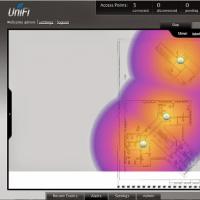Network and Sharing Management. Solved: Network and Sharing Center won't open. Types of home networks
I somehow went to the Control Panel in the Network Control Center and general access and saw this picture - the page could not be loaded:
I decided that some system files were damaged, opened command line as administrator and started the check with the command sfc / scannow but the check ended abruptly at 18% with a notification that the check was complete and found damaged files which could not be restored. For windows 7 if installed necessary updates, there is another way to restore system files using the command DISM / Online / Cleanup-Image / ScanHealth- it immediately scans and restores system files(in Windows 8 and 10, to restore system files, the last key should look like this - / RestoreHealth). The picture below shows three commands that I executed and, accordingly, the results of their execution:
In general, DISM rustled, restored something, after it Sfc check it reached 100% and finished, but the damaged files were still in place and the Network and Sharing Center still did not open complaining that the page could not be loaded. There are several more options for restoring system files and the system in particular:
- rollback to one of the previous restore points,
- recovery from the image,
- attempting to restore from the Recovery Console,
- reinstalling windows in update mode.
For some reason, there were no restore points or pre-created images on this computer, so the first two options were not available to me, in order to restore system files from the console I will need bootable USB drive, we boot from it and after choosing the language, you need to select at the bottom left of the window:
And then a window like this will appear:
In it, you can try the options marked with numbers 1 and 2, and in the first case, all the files will remain in place, in the second, you will get the system with the state on the specified date, so everything required files on the system disk must be copied somewhere in advance. My third option is to launch the command line and write in it: sfc / scannow / offbootdir = D: \ / offwindir = D: \ windows- where D is a letter system disk, the easiest way to find out is by typing Notepad in the command line - notepad will start, in it you need to go to the file menu -> open and determine the drive letter with installed Windows, it and substitute it in the command above. But in my case, this command also failed, then the last option remains after its completion, I run again Sfc / scannow this time everything is in order, the system files are restored.
Today, there is an Internet connection in almost every home. Some people are limited to one computer. Others buy routers and set up a home LAN across multiple devices (including smartphones). In any case, in order to do everything right, you need to know how correct setting local network in Windows 7. This is the topic of this article.
Network and Sharing Center
This menu is the heart of all settings network connections on Windows. Configure a local network, change the IP address, find out the MAC address of your network card, create a new PPPoE connection - you can do it all here. Of course, all actions can be performed through the command Windows string, but for most users this method will be very inconvenient.
To bring up the "Control Center" in Windows 7, you can go in several ways:

Connecting to new network equipment
Let's say you've connected to your ISP and bought yourself a new router. The configuration of the router itself is not covered in this article - there is too much variety. When the device is fully configured and ready for use, you need to connect your personal computer to it.
You connect the router and PC with a patchcord, and the network connection icon in the Windows tray changes to appearance... This means that everything is fine with the network card and cable. If your router is in DHCP mode, i.e. independently assigns IP addresses to new devices - most likely, no additional settings you don't need it.
The operating system will ask you to select the type of connection: "Public", "Home" or "Work" network. For an ordinary Windows user this step does not matter. Select, for example, home and click "Ok". Try to go online - if everything works, you don't need to do anything else. 
If not, you need to configure the adapter, which is just below.
Note! If you don't have a router and you plug in a cable from your ISP to your computer, it probably won't work for you. Modern ISPs rarely use DHCP technology, preferring PPPoE or Static IP. In this case, follow the further instructions.
Configuring adapter parameters
This section of the manual is intended for those users who need to configure the properties of the adapter (network card). If, according to the agreement with the provider, you need to assign a specific IP or mask, specify a specific gateway - follow the instructions. If the agreement contains a login and password for connection, skip this step and go to the section on PPPoE.

New home connection
If you connect with a cable directly to the provider, bypassing the router, most likely you will need to do the following.
Microsoft continues to actively improve Windows 10, introduce new features, and redesign the interface. One of the directions of these changes is the abandonment of the classic "Control Panel", which was previously used to Windows settings, and move to the more modern Options menu.
For example, before, in order to open the "Network and Sharing Center" you had to right-click on the network connection icon on the taskbar. This method until recently worked in Windows 10, but for latest versions it is no longer relevant. In this regard, many users have a question about how to open the "Network and Sharing Center" in new Windows versions 10.
In fact, the "Network and Sharing Center" opens in much the same way as before, just now you need to make one extra click. To do this, right-click on the network connection icon on the taskbar and select "Open Network and Internet Settings" in the menu that opens.
As a result, you will see the "Options" menu with open section"Network and Internet - Status". Here you need to scroll the page to the very end. Almost at the very bottom there will be a link "Network and Sharing Center". By clicking on this link you will get access to the section "" you need.

Alternatively, the Network and Sharing Center can be opened with the command "control / name Microsoft.NetworkAndSharingCenter". To do this, press the combination Windows-R keys and in the window that opens, run the specified command.

If you wish, you can even make a shortcut that will execute the command "control / name Microsoft.NetworkAndSharingCenter" and thereby open the network control center. To do this, right-click on the desktop, select "Create - Shortcut", enter the command and save.
Nowadays, each user is faced with the question of setting up a network in the Windows 7 operating system. If you are a home user, you will someday be faced with the task of setting up an Internet connection, synchronizing with the game XBOX prefix, and if you have several units at home computer technology, then in any case you will have to configure the wired or wireless network, and one computer will have to distribute the Internet to all the others. In the event that you work system administrator small office, you will need to set up a network with static or dynamic addresses. Unfortunately, many users usually try to set up a local network without having the skills to work with network technologies, and therefore they carry out the tuning at random, which is why they have a lot of problems in the subsequent work. This series of articles is devoted to various methods of configuring a local network, terminology, and connection to the World Wide Web.
Often, setting up a local network in operating systems Windows Vista, Windows 7, Windows Server 2008/2008 R2 starts with the area of configuring network properties as a component. With help this tool When configuring networks, you can choose your network location, view a network map, configure network discovery, file and printer sharing, and configure and view the status of your current network connections. In this article, you will learn how to manage this component.
Opening the Network and Sharing Center component
In order to use the functionality of the network configuration tool, you first need to open it. To open a window "Network and Sharing Center", Perform one of the following actions:
The following illustration shows the window "Network and Sharing Center":
Rice. 1. "Network and Sharing Center"
Network location concept
Before starting work with this component, you should understand such a concept as network location... This setting is set for computers when they first connect to the network, and during connection, the firewall and security settings are automatically configured for the type of network to which you are connecting. Unlike operating system Windows Vista, which uses the strictest network hosting firewall profile for all network connections, Windows 7 supports multiple active profiles, which allows the most secure use of multiple network adapters connected to different networks. There are four types network location:
home network ... This network location is intended for use at home or on networks where users know each other very well. These computers can create and join home groups. For home networks, network discovery is automatically turned on.
Enterprise network... This network location is used in the Small Office Network (SOHO). Network discovery is also enabled for this network location, but you can neither create nor attach a computer to home group.
Public network... This network location is for use in public places such as coffee shops or airports. This is the strictest placement, and has the ability to join a homegroup and network discovery disabled by default.
Domain network... If the computer is joined to a domain Active Directory, then the existing network will be automatically assigned the type of network location "Domain"... The domain type of network location is similar to the work network, except that the domain has the Windows Firewall configuration network discovery and also the network card is determined by group policy.
The network locations available for user selection can be seen in the following illustration:
Rice. 2. Choosing a network location
Network map
The network map is graphical representation location of computers and devices, which allows you to see all the devices on your local network, as well as a diagram of their connection to each other. In the window "Network and Sharing Center" only the local part of the network card is displayed, the layout of which depends on the available network connections. The computer on which the map is being generated is displayed in the left upper corner... Other computers on the subnet are displayed on the left. Infrastructure devices such as switches, hubs, and gateways to other networks are displayed on the right. You can see an example of a network map in the following illustration:
Rice. 3. An example of a network map
Two components are responsible for the operation of the network map in operating systems:
Link Layer Topology Discover Mapper (LLTD Mapper) - a component that requests devices on the network to include them in the map;
Link Layer Topology Discover Responder (LLTD Responder) - the component that is responsible for the requests of the LLTD Mapper component.
By default, the network map can only be viewed for locations "Home network" or "Enterprise network"... When trying to view the network card for locations "Domain network" or "Public network" you will see the following message:
Rice. 4. Trying to view the network map for the location of the domain network
In order to enable network mapping in a domain network, you need to perform the following steps on a domain controller:
Rice. 5. Change group policies to enable network mapping
Rice. 6. Network map for the location of the domain network
- Open the snap "Group Policy Management";
- Select a group policy object (for example, Default Domain Policy, scope - entire domain) that will be applied to the computer located in the domain network, right-click on it and select the command from the context menu "Change";
- In snap "Control Editor group policies» expand the node Computer Configuration / Policies / Administrative Templates / Network / Link Layer Discovery and select a policy "Includes I / O Mapping Driver (LLTDIO)";
- In the properties of the policy setting, set the radio button to the option "Turn on" and check the box "Allow operation for domain";
- Repeat similar actions for policy setting Enable Responder Driver (RSPNDR);
- Update the policy settings on the client machine using the command gpupdate / force / boot;
- Refresh the network map. The result is shown in the following illustration:
Network connections
After installing the driver for each network adapter, the Windows operating system tries to automatically configure the network connections on the local computer. All available network connections are displayed in the window "Network connections"... A network connection is a collection of data required to connect a computer to the Internet, a local network, or any other computer.
Open window "Network connections" you can do any of the following:
Window "Network connections" shown in the following illustration:
Rice. 7. Window "Network connections"
When choosing any network connection, you can do the following with it:
In the opened dialog box "Diagnostics Windows networks» follow the steps in the wizard to troubleshoot.
Check boxes next to components indicate that these components are bound to the connection. The network connection properties dialog box is shown below:

Rice. 11. Dialog box of properties of network connection

Conclusion
This article briefly introduces the components of the Network Properties Configuration Tool for operational Windows systems - "Network and Sharing Center"... The concepts of network location, network cards are considered, with the help of which the local part of the network card is displayed, the layout of which depends on the available network connections. You also familiarized yourself with the network connections window, which allows you to configure network connections on the local computer. In the next article, you will learn how you can configure clients, services, and network protocols using the graphical user interface.
Windows 10 users are well aware that Microsoft is slowly dragging and dropping elements of the classic control panel into a new app (as much as you can call a new app that is three years old) Settings. Traditionally, the software giant drives horses - the speed with which the control panel is buried in the jungle of the operating system does not match the speed with which the elements of this control panel are moved to Settings. That is why users often have to search the Internet for paths by which they can get to old interfaces that have not yet been rewritten in the new application. The Network and Sharing Center in Windows 10 is one of those. This article will tell you how to open the Network and Sharing Center in Windows 10 on builds that are current as of early 2018.
Network and Sharing Center.
V previous versions Windows 10, the user could get into the Network and Sharing Center by right-clicking on the network connection icon in the notification area. Unfortunately, this method is no longer valid, since instead of linking to the classic interface, there is now a button that launches the usual Settings application in the network connections section. This does not mean that there is no way left in the system to open the old interface. Here we have collected all the ways that you can use to open the Network and Sharing Center in Windows 10.
How to open the Network and Sharing Center via the Run command
This method is a stick with two ends. On the one hand, it is simple because it only requires you to press Win + R and enter a command. On the other hand, you need to learn a complex command and not be mistaken in the name. Since this method involves a minimum of steps, let's start with it.
For reference: almost every section of the control panel has its own corresponding command that you can use to quickly open the section you need. You can easily find a list of these commands on the Internet.

Launching Network and Sharing Center from Control Panel
If you know how to open the Control Panel in Windows 10, then finding the section with network settings will not be difficult for you.

Opening the Network and Sharing Center via Settings
The principle is the same as in previous versions of Windows 10, only with a few additional steps. The links to the classic interface remain in the Parameters - you just need to find them.

How to create a shortcut to Network and Sharing Center
If you have to run this section often, it makes sense to create a shortcut on the desktop or taskbar.

How to open Change adapter settings Windows 10
If you are looking specifically for a list of network connections in your computer (changing adapter parameters), you can cut a little and immediately get into the interface you need. This is done as follows, by analogy with the previous steps: press Win + R and enter ncpa.cpl.

There is another option:

Nobody rules out the fact that in Windows 10 1803 and newer than Microsoft it will bury the control panel even deeper and some of the above methods will stop working. If this happens, we will update this article accordingly.
 Can I use Google Play Market on Lumia?
Can I use Google Play Market on Lumia? Description and secrets of the current tariff zero doubts on the beeline
Description and secrets of the current tariff zero doubts on the beeline MTS option “Russia is at home everywhere
MTS option “Russia is at home everywhere Seamless Wi-Fi Useful reviews about the work of capsman
Seamless Wi-Fi Useful reviews about the work of capsman How to talk to Alice Screenshots Yandex with Alice
How to talk to Alice Screenshots Yandex with Alice Mts bonus program is closed
Mts bonus program is closed Mobile communications and internet in the resorts of montenegro
Mobile communications and internet in the resorts of montenegro